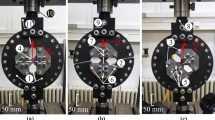Abstract
The commonly used wrinkling evaluation methods such as cup forming and the Yoshida buckling test (YBT) only consider the symmetric sheet specimen and loading, therefore a deviation from the reality is inevitable. A method using the asymmetric specimen (AS) under offset loading is proposed and investigated with two materials SUS304 and DC04. Results show that the unbalanced external force in AS induces special stress state that is not included in YBT at wrinkling onset, where the shear stresses are dominant. The length and height evolution of the wrinkle is controlled by the principal stresses, and the direction gradually approaches the tensile axis during deformation. The shear stress decreases with the length/width ratio increases, but it rises at first and then falls when the clamping width increases. The error between the simulation and experiment is 2.9 %. This method can be used to examine the shear wrinkling properties of sheet metal.
Similar content being viewed by others
References
C. Won et al., Wrinkling prediction for GPa-grade steels in sheet metal forming process, The International Journal of Advanced Manufacturing Technology, 102 (2019) 3849–3863.
J. J. Lee and G. J. Park, Optimization of the structural and process parameters in the sheet metal forming process, Journal of Mechanical Science and Technology, 28(2) (2014) 605–619.
L. Chen et al., Finite element simulation and model optimization of blankholder gap and shell element type in the stamping of a washing-trough, Journal of Materials Processing Technology, 182(1–3) (2007) 637–643.
M. R. Morovvati, B. Mollaei-Dariani and M. H. Asadian-Ardakani, A theoretical, numerical, and experimental investigation of plastic wrinkling of circular two-layer sheet metal in the deep drawing, Journal of Materials Processing Technology, 210(13) (2010) 1738–1747.
M. A. Hassan et al., A novel process on friction aided deep drawing using tapered blank holder divided into four segments, Journal of Materials Processing Technology, 159(3) (2005) 418–425.
W. R. Wang et al., Determination of optimal blank holder force trajectories for segmented binders of step rectangle box using PID closed-loop fem simulation, The International Journal of Advanced Manufacturing Technology, 32(11–12) (2007) 1074–1082.
J. Cao, Prediction of plastic wrinkling using the energy method, Journal of Applied Mechanics, 66(3) (1999) 646–652.
J. B. Kim and D. Y. Yang, Prediction of wrinkling initiation in sheet metal forming processes, Engineering Computations, 20(1) (2003) 6–39.
B. G. Teng, K. Li and S. J. Yuan, Optimization of loading path in hydroforming T-shape using fuzzy control algorithm, The International Journal of Advanced Manufacturing Technology, 69(5–8) (2013) 1079–1086.
B. Du et al., Determining factors affecting sheet metal plastic wrinkling in response to nonuniform tension using wrinkling limit diagrams, Thin-Walled Structures, 147(106535) (2020) 1–15.
M. Khademi, H. Gorji and M. Bakhshi-Jooybari, Effects of material and process parameters on wrinkling of conical parts in modified hydroforming process, The International Journal of Advanced Manufacturing Technology, 116 (2021) 259–279.
K. Yoshida, Purpose and feature of Yoshida buckling test, Journal of the Japan Society for Technology of Plasticity, 24(272) (1983) 901–903.
J. B. Kim, J. W. Yoon and D. Y. Yang, Wrinkling initiation and growth in modified Yoshida buckling test: finite element analysis and experimental comparison, International Journal of Mechanical Sciences, 42(9) (2000) 1683–1714.
J. Cao et al., Buckling of sheet metals in contact with tool surfaces, CIRP Annals — Manufacturing Technology, 56(1) (2007) 253–256.
G. S. Cai et al., A novel approach to predict wrinkling of aluminum alloy during warm/hot sheet hydroforming based on an improved Yoshida buckling test, Materials, 13(5) (2020) 1–19.
J. Cao, X. Wang and F. J. Mills, Characterization of sheet buckling subjected to controlled boundary constraints, Journal of Manufacturing Science and Engineering, 124(3) (2002) 493–501.
E. Bayraktar, N. Isac and G. Arnold, Buckling limit diagrams (BLDs) of interstitial free steels (IFS): comparison of experimental and finite element analysis, Journal of Materials Processing Technology, 164–165 (2005) 1487–1494.
F. Han and M. Liewald, A new method to enhance the accuracy of the buckling test using modified yoshida sample, Advanced Materials Research, 1018 (2014) 199–206.
S. Sven and V. Wolfram, Optimization of the modified Yoshida buckling test to investigate the influence of curvature, Advanced Materials Research, 1140 (2016) 67–74.
L. J. Cui and W. C. Zhang, Effect of properties of sheet metal on shear stress wrinkling, Transactions of Nonferrous Metals Society of China, 13 (2003) 157–160.
B. Du et al., A Shear Stress Wrinkling Test Device for Sheet Metal and Its Measurement Method of Instability, Chinese Patent 10167893.9, China National Intellectual Property Administration (2021).
J. P. Davim, Statistical and Computational Techniques in Manufacturing, Springer-Verlag Berlin Heidelberg, Germany (2012).
T. Iwasa, Experimental verification on wrinkling behavior given by wrinkling analysis using the tension field theory, International Journal of Solids and Structures, 136–137 (2018) 1–12.
J. Chakrabarty, Theory of Plasticity, 3rd Ed., Elsevier Butterworth-Heinemann, Oxford (2006).
Acknowledgments
This work was supported by the Natural Science Foundation of Chongqing, China (cstc2020jcyj-msxmX0420) and the National Natural Science Foundation of China (Grant No. 51575066).
Author information
Authors and Affiliations
Corresponding author
Additional information
Haoxing Tang is a Ph.D candidate of Chongqing University. His research interests include sheet forming analysis and defect control.
Tong Wen is a Professor at Chongqing University. His current research interests include advanced materials processing technologies and numerical simulation methods in metal forming.
Rights and permissions
About this article
Cite this article
Tang, H., Wen, T., Hong, J. et al. Analysis of shear stress wrinkling of asymmetric sheet specimen under offset loading. J Mech Sci Technol 36, 1451–1457 (2022). https://doi.org/10.1007/s12206-022-0232-5
Received:
Revised:
Accepted:
Published:
Issue Date:
DOI: https://doi.org/10.1007/s12206-022-0232-5




